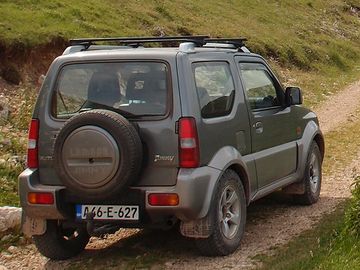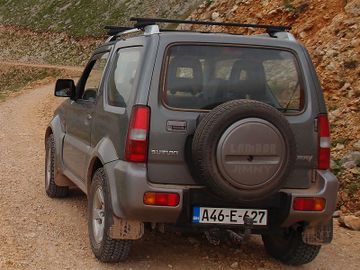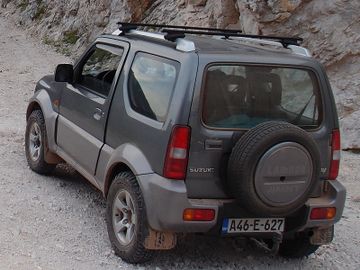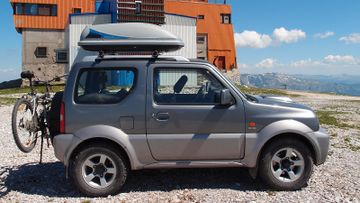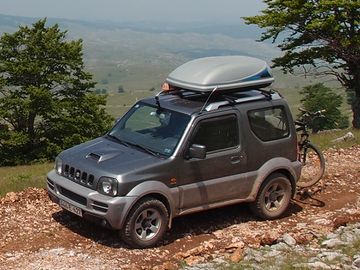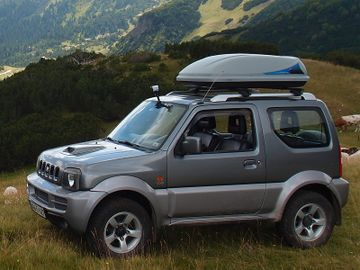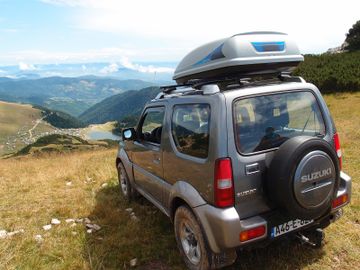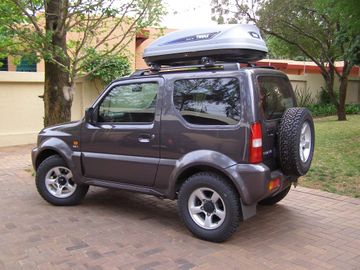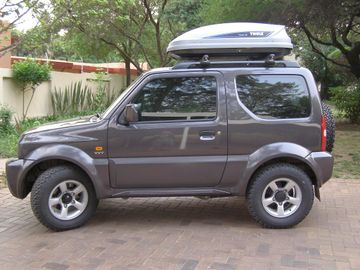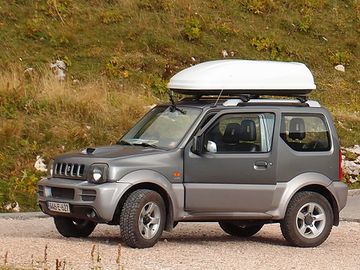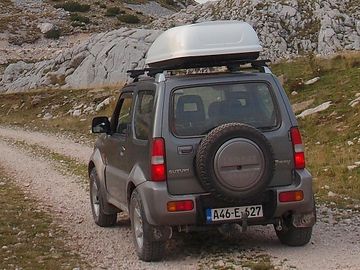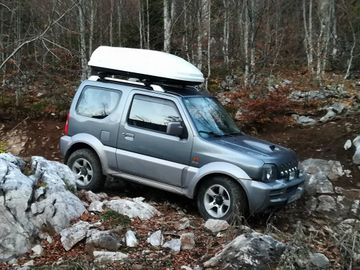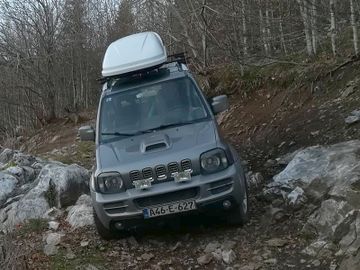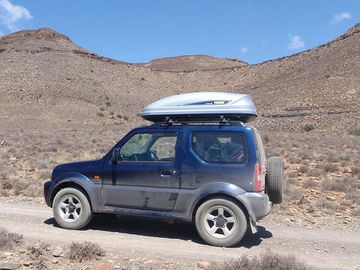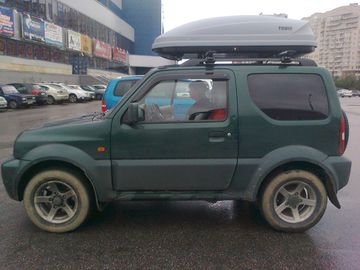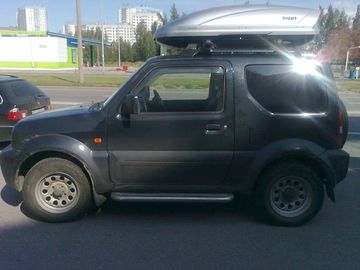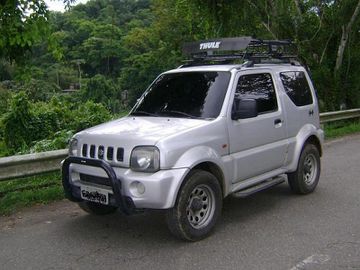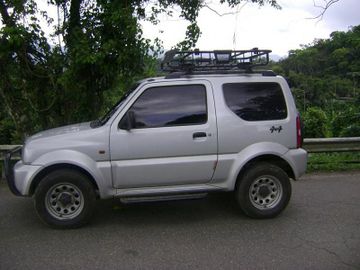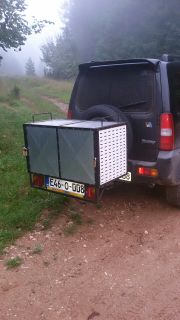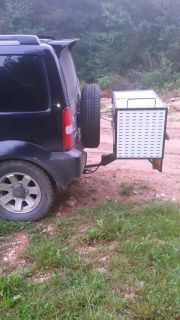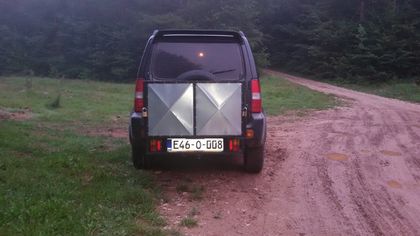![]() The content of any article might be expanded / improved in the future - revisit it sometimes.
The content of any article might be expanded / improved in the future - revisit it sometimes.
![]() Seen a mistake? Know something that isn't written? Edit and change this article yourself!
Seen a mistake? Know something that isn't written? Edit and change this article yourself!
![]() Some images in the article (if present) can be enlarged by clicking on them.
Some images in the article (if present) can be enlarged by clicking on them.
Contents
Introduction
One of Jimny's most significant usability weaknesses is the lack of cargo space.
The trunk is tiny. But even worse, the trunk has no cover, so anyone can see its contents.
There are several solutions to add more cargo space, "extract" more usable space from the existing one, and to hide cargo from public eyes.
Solutions for increasing and managing the cargo space
- Use transversely mounted roof rails;
- Use a roof mounted plastic box;
- Use a roof mounted steel basket;
- Use a towbar mounted box;
- Use a suitably sized hard-case bag in the trunk, with sectioned chambers in the bag (similarly like a toolbox);
- Use genuine OEM flexible (nylon) rear cargo tray over the folded rear seats [P.N. 990E0-84A14-000];
- Use genuine OEM hard plastic rear cargo tray over the folded rear seats [P.N. 990E0-81A01-000];
- Use genuine OEM hard plastic rear cargo flat tray set over the folded rear seats [P.N. 990E0-84A30-SET];
- Use genuine OEM "cargo area divider" steel grid, which installs vertically behind the rear seats and prevents rear cargo from interfering with the front cabin area [P.N. 00800-41268-GIT];
- Use genuine trunk cargo restraining net [P.N. 99000-99025-63W];
![]() Read the wiki article "Accessories for Jimny (genuine Suzuki)" for details on these OEM accessories.
Read the wiki article "Accessories for Jimny (genuine Suzuki)" for details on these OEM accessories.
Solution #1 is also the prerequisite for solution #2.
Solution #2 is the traditional solution for expedition and overlanding trips. It provides the most flexibility but no privacy for the cargo.
Solution #4 might not be legal, or might require the use of additional license plate and brake + turn lights.
Solutions for hiding the cargo
- Use genuine OEM sun shade plates for the rear window and side rear windows [P.N. 990E0-81A00-000];
- Apply aftermarked-made tint foils to your rear windows and side rear windows (caution: might not be legal);
- Put the cargo in a roof box;
- Put the cargo in a towbar mounted box;
- Put a blanket over the cargo in the trunk (could be counter-intuitive!);
- Make DIY trunk cover;
Solution #1 might not totally obscure the vision from the outside towards the inside, depending on lightning conditions on the location.
Solution #3 provides the best concealment, but can be quite awkward (roof box is very high up, also the need to operate it separately from the car's locks, etc.).
Solution #5 might even entice additional curiosity from the viewer.
Solution #6 requires some ingenuity to modify an OEM trunk cover from some other vehicle. One person had good success modifying Ford Ka's OEM trunk cover to suit Jimny.
Roof rails/racks
- A pair of transversely mounted roof racks (rails) provides a very practical platform for carrying bulky cargo (furniture, planks, bars, pipes, funeral caskets, big guns, etc.).
- Such roof rails are also a prerequisite for mounting roof boxes, ski carriers, bicycle carriers, etc.
- Most aftermarket-made, Jimny-compatible transverse roof rail models mount on Jimny's longitudinal factory roof rails.
- However, all "cabrio" Jimnys, as well as some (mostly low-end) "closed cabin" Jimnys don't have those longitudinal rails. There are no known aftermarket-made transverse roof rails for such Jimnys.
- Therefore, if you have a "cabrio" Jimny, or a closed-cabin Jimny without factory longitudinal roof rails, you can not mount roof rails nor a roof box.
- Jimny with transverse mounted steel roof rails (Thule SquareBar 761) and Thule 775 connecting 'feet'
![]() If you have a closed cabin ("tin-top") Jimny without longitudinal rails, you might be able to transplant the rails from another dead Jimny from a vehicle junkyard (this has not been tried yet). This is certainly not possible on cabrio Jimnys, even with the hard top.
If you have a closed cabin ("tin-top") Jimny without longitudinal rails, you might be able to transplant the rails from another dead Jimny from a vehicle junkyard (this has not been tried yet). This is certainly not possible on cabrio Jimnys, even with the hard top.
Roof boxes
Prerequisites
- The prerequisite for mounting any roof box is having a pair of transversely mounted roof racks (rails).
- See the preceding chapter for details about roof rails.
Advantages of using a roof box
- Roof box provides a significant expansion of the cargo space in (on) a Jimny. For example, Jimny's boot volume is around 110 litres, while the volume of Thule's "200 / M" size-class roof boxes is around 400 liters.
- The content of a roof box is invisible when the roof box is closed, providing much needed privacy for the cargo, which Jimny's boot does not provide.
- Larger roof boxes can contain relatively large or long items, which are difficult to fit in Jimny's rear. Examples: skis, planks, bars, shovels, baby carriages, chainsaws, oversized dildos, machine guns ...
- If the roof box is painted in some light color, its contents will not warm up as much as the interior of the vehicle on a sunny day. This can be quite convenient for some items.
- The use of a roof box should be legal in all countries of the world without any additional certifications or paperwork.
Disadvantages of using a roof box
- Jimny's roof is rather tall, so access to the roof box is rather complicated and difficult. To access the roof box, it is usually necessary to either stand on the side door sill or (more often) on the rear wheel. While standing so, you will have to use one arm to hold yourself to vehicle's longitudinal roof rail, and only the remaining arm to work on the cargo. Also, it is sometimes difficult to put the foot between the rear wheel and the wheel arch due to the lack of space (undulated ground or loaded vehicle).
- Because the roof box is on a rather tall position, putting heavy or oversized items in/out of the roof box can be a challenge and might even require collaboration of two persons (or one strong man and a nagging wife).
- Jimny is a narrow, tall vehicle, which wobbles around. A roof box raises the center of gravity, thus further worsening this ratio. This is not really noticeable when the roof box is empty, but it certainly is when it is full of heavy items.
- Maximum load of most roof boxes is only 50 kg. Some better models can handle up to 75 kg. However, putting more than 50 kg on Jimny's roof might not be a good idea anyway.
- Jimny is significantly over two meters tall with the roof box on.
- This restricts access to many garages and closed spaces.
- You must be careful not to hit a ceiling when entering closed garages in shopping centers etc.!
- Lots of people have destroyed their roof boxes on the very first day of owning them, by not thinking about this!
- Also warn your mechanic about the height, so he does not hit a ceiling when lifting the car in a service garage.
- If you have your own garage for parking your Jimny, then having a roof box might not be an option at all, depending on the height of the ceiling in the garage.
Roof boxes off road
- You can regularly go off road with the roof box on, just bear in mind that your center of gravity is higher with the roof box on (especially with cargo in it).
- It is important that the box is of high quality so that it can withstand vibration abuse when driving on gravel and off road.
- When driving through very overgrown tracks in forests, the roof box might collide with low branches. This requires extra caution not to hit thick / strong branches, which have to be cut off before passing.
User experiences
- Forum user Bosanek used Thule "100" ("S") and "200" ("M") size roof boxes on his Jimny.
- There are other quality roof box manufacturers of course, and other readers are welcome to write about their own experiences here.
- Thule boxes have several models, but their sizing ranges are approximately standardized across the model range.
- The smallest Thule roof box size range used to be "80", but it has been discounted in most markets;
- Example is roof box model "Thule Ocean 80", with volume of face="Courier">320 l and dimensions (L x W x H) 133 x 86 x 37 [cm];
- Such roof boxes can still probably be found on the second hand market.
- Their smallest current roof box size is called "100" / "S" (depending on the market);
- Size 100 / S main data: approximate volume 330-370 l (depending on roof box design), approximate dimensions (L x W x H) 140 x 90 x 40 [cm];
- Examples of Thule roof boxes in size 100 / S: Polar 100, Ocean 100, Pacific 100, Touring 100, Touring S, Motion S, etc.;
- Suzuki Jimny with roof box Thule Ocean 100
- Suzuki Jimny with roof box Thule Pacific 100
- The next larger Thule roof box size is called "200" / "M" (depending on the market);
- Size 200 / M main data: approximate volume 410-460 l (depending on roof box design), approximate dimensions (L x W x H) 175 x 82 x 45 [cm];
- Examples of Thule roof boxes in this size 200 / M: Polar 200, Ocean 200, Atlantis 200, Pacific 200, Touring 200, Touring M, Motion M, etc.;
- Suzuki Jimny with roof box Thule Ocean 200
- Suzuki Jimny with roof box Thule Pacific 200, and Motion 200 (3rd picture)
- The next larger Thule roof box size is called "780" / "L" (depending on the market).
- Size 780 / L main data: approximate volume 420-480 l (depending on roof box design), approximate dimensions (L x W x H) 197 x 78 x 43 [cm];
- Examples of Thule roof boxes in this size 780 / L: Atlantis 780, Ocean 780, Pacific 780, Pacific L, Touring L, etc.;
- Size 80 is a bit too small, but fits quite nicely nonetheless.
- Sizes 100 / S and 200 / M fit great.
- Size 780 / L also fits, but looks just a bit bulky (pictures needed!).
- Anything larger than that looks like a boat on the roof.
Roof baskets
- Roof baskets provide the most versatility and the best utility value.
- Apart for being able to store various items "inside" them (just like in a roof box), you can also attach various items to their sides, like shovels, tools, flags, radars ...
- However, all items have to be secured well and insulated from adverse weather.
- Roof baskets are best suited for remote overland expeditions where population is scarce and you never move far away from the car - another person (or a monkey) can easily mess with the cargo on the roof!
- Suzuki Jimny with roof basket Thule Xperience 828
Towbar mounted boxes
If you are desperate for having additional cargo space in a Jimny (and who isn't!?), you might also consider using a towbar mounted cargo box.
An example of a towbar mounted cargo box is "Thule BackUp 900". That one can even be combined with some of their platform mounted towbar bicycle carriers.
Specially designed towbar mounted cargo boxes with ventilation openings are used by some hunters to transport hunting dogs.
An example of a custom-made towbar mounted dog box on a Jimny:
That dog box on the pictures with a black Jimny is additionally secured to the car by a pair of straps linking it with the rim of the spare tyre. That reduces the vibrations inside the box during driving. Alternatively, the securing straps could be designed to attach to each side of the rear doors, in a similar manner like this Italian bicycle carrier uses them.
![]() Read the wiki article "Towbar" for details on installing a towbar (if you don't have it) and using the existing one.
Read the wiki article "Towbar" for details on installing a towbar (if you don't have it) and using the existing one.
Beware that a towbar mounted cargo box will block the rear door, so you can not open the rear door while the box is mounted. You can not open the door even if the box is a tiltable design, because no matter how much you tilt it away, it won't provide more than a couple of inches of space to open the door. The spare tyre is the main cause of the lack of maneuverability.
Bicycle carriers
Bicycles are also a type of cargo.
However, the topic of choosing and using bicycle carriers is so large that it exists as a separate wiki article called Bicycle carriers.
Page last edited on 28/11/2017 by user Bosanek


